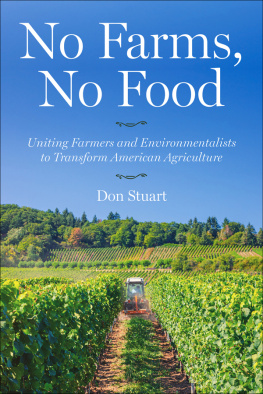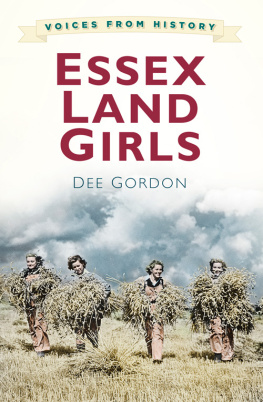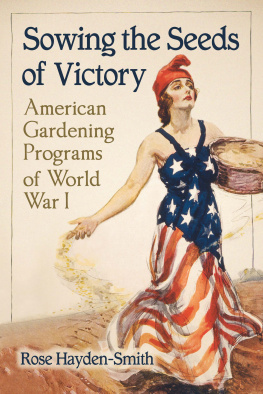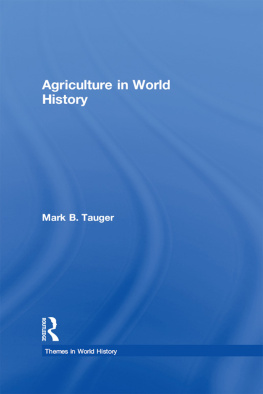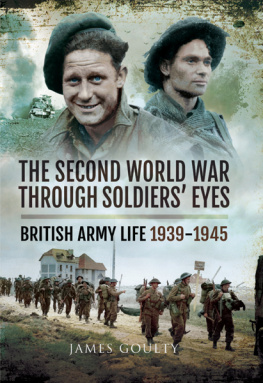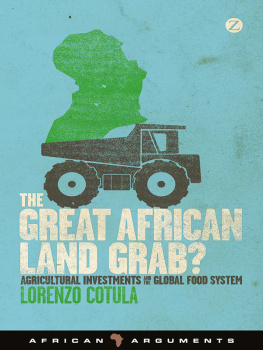Holding the Home Front
The men must take the swords,
And we must take the ploughs,
Our Front is where the wheat grows fair,
Our Colours, orchard boughs.
Come out of the towns
And on to the downs
Where a girl gets brown and strong,
With swinging pace
And morning face
She does her work to song.
The children shall not starve,
The soldiers must have bread,
Well dig and sow and reap and mow,
And England shall be fed.
From the Land Army Song.
Holding the Home Front
The Womens Land Army in the First World War
Caroline Scott
First published in Great Britain in 2017 by
PEN AND SWORD HISTORY
an imprint of
Pen and Sword Books Ltd
47 Church Street
Barnsley
South Yorkshire S70 2AS
Copyright Caroline Scott, 2017
ISBN 978 1 78383 112 8
eISBN 978 1 47388 632 2
Mobi ISBN 978 1 47388 631 5
The right of Caroline Scott to be identified as the author of this work has been asserted by her in accordance with the Copyright, Designs and Patents Act 1988.
A CIP record for this book is available from the British Library All rights reserved. No part of this book may be reproduced or transmitted in any form or by any means, electronic or mechanical including photocopying, recording or by any information storage and retrieval system, without permission from the Publisher in writing.
Pen & Sword Books Ltd incorporates the imprints of Pen & Sword Archaeology, Atlas, Aviation, Battleground, Discovery, Family History, History, Maritime, Military, Naval, Politics, Railways, Select, Social History, Transport, True Crime, Claymore Press, Frontline Books, Leo Cooper, Praetorian Press, Remember When, Seaforth Publishing and Wharncliffe.
For a complete list of Pen and Sword titles please contact
Pen and Sword Books Limited
47 Church Street, Barnsley, South Yorkshire, S70 2AS, England
E-mail:
Website: www.pen-and-sword.co.uk
Illustrations
Fig 1. How Women are Filling the Gaps in the Ranks; Women sheaving corn, Missenden, Buckinghamshire.
Fig 2. Womens trip to observe French farm work.
Fig 3. Lady Denman who takes a keen practical interest in poultrykeeping.
Fig 4. Cicely Spencer, Forage Corps.
Fig 5. The War-Brownies at work on a farm.
Fig 6. The farmers daughter, Miss Luke, is herself driving the machine, and a soldier in khaki is at the side.
Fig 7. Picturesque War-Work: The Lady Shepherd.
Fig 8 and 9. Bessie (Cuckoo) Ziman and fellow workers.
Fig 10 and 11. Womens War-Work on a Royal Farm.
Fig 12. Girl-pupils spreading manure in the snow in Nottinghamshire.
Fig 13. Initial advert for the Womens Land Army, widely placed in the press in March 1917.
Fig 14. Advert for the Womens Land Army.
Fig 15. A farm wagon-load of women land-workers in Worcestershire are setting out to work.
Fig 16 and 17. Women working in the forests of Brent Tor, Devon.
Fig 18. Timber measurers working with a gang of Portuguese treefellers.
Fig 19. Beatrice Bennett and fellow Womens Land Army trainees, Kent, 1917.
Fig 20. Beatrice Bennett and fellow timber workers at Chilgrove Camp.
Fig 21. A wood-woman.
Fig 22. Women mole catchers on an estate in the Cotswolds.
Fig 23. Recruiting rally for the Women's Land Army, Preston.
Fig 24 and 25. Recruiting rally for the Women's Land Army, Preston.
Fig 26. Flax pullers, Crewkerne, Somerset, 1918.
Fig 27. Beauty on Duty has a Duty to Beauty.
Fig 28. Advert for Woman Power insurance.
Fig 29. Cartoon by Bunty Daniel, a Land Girl, contrasting assumptions about, and the realities of, land work.
Fig 30. Cartoon by Bunty Daniel.
Fig 31 and 32. Clothing adverts from The Landswoman .
Fig 33. Montage showing varieties of work at Great Bidlake Farm, Devon.
Fig 34. The Recruiter. Cartoon by Bunty Daniel.
Fig 35. Cover for the special Christmas issue of The Landswoman , December 1918.
Introduction
In recent years the Womens Land Army has received some longoverdue formal recognition, firstly with the issue of a commemorative badge to veterans and a reception at Downing Street in 2008, and then with the unveiling of a statue at the National Memorial Arboretum in 2014. On both occasions women who had been members of the Land Army during the Second World War reflected that it had felt like their contribution had been forgotten after the 1940s.
The Land Girl might well have been out of sight and out of mind through much of the second-half of the twentieth century, but popular culture discovered her around the turn of the millennium. Over the past fifteen years films, television series and novels have seen Land Girls pushing their way into our line of sight. That gutsy girl, winning over the sceptical farmer and stolid rustics with her charm and chat, has become almost a clich. Veterans of the Second World War have, understandably, sometimes reacted angrily to these over-coloured retellings of their experiences. Indeed, its been observed that they have little basis in truth; this is a phoney war with far too much flirting and not nearly enough dirt and hard graft. The authenticity of the onscreen Land Girl is certainly doubtful, her exploits much romanticised, and shes frequently to be found with anachronistic values falling out of her lipsticked mouth, but theres no danger of the public forgetting about her. (Theres no danger that shell let us forget.) We might be misremembering her, we might have distorted her image into one that suits a twenty-first century audience, but we havent forgotten. Other things have been forgotten, though. One could be forgiven for supposing that women first stepped out into the fields in 1939, but its a much older and more complicated story.
Even in histories of the Womens Land Army, the First World War doesnt get too much of a look-in. The period of 1917-19 is generally quickly prcised, condensed into an introductory chapter to set the scene for the Second World War. And perhaps understandibly so. The Landswomen of the First World War are rather more difficult to get to know than the Second World Wars Land Girls. Alas, theyve all gone now and havent left enough of themselves behind. Their experiences exist in scraps and snippets and fragments of voices. They didnt mean to fade away, though. As soon as the war was over, women began curating their own history, committing their experiences to paper and to museums. In 1920, invited by the new Imperial War Museum, they posted off badges and certificates and accounts of their wartime lives to London. The museum wanted to create a permanent record of the work performed by women during the war and land workers responded readily to the invitation to participate. In 1920 they wanted to have their voices heard. But time nudged on and the prevalent mood wasnt one for lingering in reminiscence. The women themselves were making homes and families, and social and economic forces were testing the resolve of those who tried to cling on and make a career on the land. Then, all too soon, another war was eclipsing the story of the Landswoman. Have we unfairly undervalued the contribution of the First World Wars female land workers, then? Has history shortchanged them?




